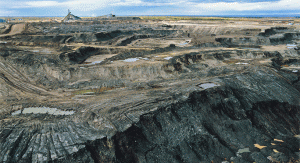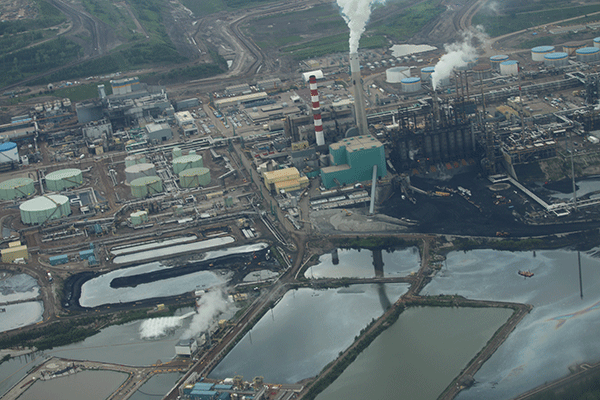by Brian Palmer, originally published by Onearth | OCT 7, 2014
The Canadian tar sands industry has seen better days. Energy giant Statoil announced last week that it would postpone a major mining project in Alberta for at least three years. It was just the latest in a string of major setbacks for tar sands oil, which has become nearly as bad for corporate profits as it is for the environment.
High labor costs and the falling price of crude oil have contributed to the industry’s dark days, but environmental activists can also take a bow. By delaying the proposed Keystone XL pipeline, which would ship tar sands oil across the Midwest to refineries on the U.S. Gulf Coast, they have helped make digging up Alberta’s boreal forest an increasingly bad investment.
How did this happen? First you need to understand a bit about the economics of tar sands oil—a cheap, off-brand version of conventional crude. (You know a product is bad when it’s compared unfavorably to oil.) Refiners don’t particularly want tar sands oil, which is tougher to make into usable transportation fuel, so it sells for about $20 to $30 less per barrel than crude from Texas or the Dakotas. Therefore, if producers can’t make it on the cheap, they can’t afford to make it at all.
Still, tar sands used to look like a decent investment. Energy producers can calculate, almost down to the barrel, how much oil can be extracted from a tar sands plot. Companies that could afford the steep upfront costs expected steady, if small, returns for decades. In June of 2013, the Canadian Association of Petroleum Producers forecasted a doubling of the country’s daily crude oil production to 6.7 million barrels by 2030. But things aren’t looking so rosy these days. CAPP’s 2014 report cut the production forecast by 300,000 barrels per day.
What changed? Extracting and processing tar sands has always been a tough business. Bitumen, the fuel component in tar sands, is nearly solid underground. Producers have to heat up prodigious amounts of water to melt the stuff and get it to flow toward the surface. Surface-level deposits are less technically challenging to access, but no greener. These projects look very much like strip mines and have some of the same environmental impacts, which include diverting and polluting rivers and streams, causing heavy erosion, and disturbing vast areas of soil. The ponds of leftover toxic waste threaten millions of migrating birds, and studies have identified health problems in the nearby indigenous communities linked to pollution.
Extracting the bitumen also demands large investments in machinery; the heavy, sticky crude requires large processing facilities to prepare it for transport. In order to make the tar sands bitumen marketable, producers have to heat the thick sludge to 500 degrees, which requires plenty more energy. All things considered, the energy you can get from burning a barrel of tar sands oil only barely exceeds the energy required to produce it.
And it doesn’t help that most of the stuff is buried in the remote northeast of Alberta. To call the area God’s country requires the iffy assumption that God remembers where he put it. Getting equipment and people to the tar sands region costs loads of money.
But the even bigger challenge is getting the oil out of there to refineries. Tar sands producers would love to send their oil to the Upper Midwest, but those refineries are already saturated with domestic crude. They have no use for the cheap stuff from Alberta. That means the tar sands oil has to travel all the way to the Gulf of Mexico—more than twice the distance.
There are two primary methods to move oil: by pipeline, which is cheap, and by rail, which is expensive. That cost differential is make-or-break for a tar sands business. The break-even price of tar sands oil is around $100 per barrel if transported by rail, according to Anthony Swift, a staff attorney at NRDC (which publishes OnEarth). Tar sands oil sells for $75 on a good day. So producers have to find a savings of $25 per barrel somewhere in order to make it worth the investment.
That’s why they’re so desperate for President Obama to approve Keystone XL—and why, in the pipeline’s absence, the narrow margins necessary to make tar sands extraction economical are starting to dissolve.
Moving oil from Alberta to the Gulf by pipeline would cost around $9 per barrel, or one-third the cost of rail transport. With a stroke of his pen, the president could almost (almost) make tar sands into a worthwhile economic proposition for investors. (Though, in the words of climatologist James Hansen, that proposition would be “game over for the climate,” which isn’t exactly a good deal for the rest of us.) And if the pipeline doesn’t get approved? Well, to put it in the simplest terms possible: No KXL, no new tar sands projects.
That is a truism that has been playing out across Alberta as the six-year (and counting!) wait for a Keystone decision—delayed many times by legal, environmental, and political concerns—continues. This year, both Shell and France’s Total SA halted tar sands projects, saying they weren’t economically viable. Last year, Suncor Energy of Canada and Total killed joint plans to build a massive bitumen upgrading plant in Alberta. “Market conditions have changed significantly,” the Suncor CEO said. The cancellation cost the companies more than $1.5 billion. And yes, the delays in building Keystone XL are playing a major role. When Statoil announced its postponed project, the company cited “limited pipeline access” as a factor.
“Tar sands extraction is a marginal business in the best of conditions,” says Swift. “As the financial risks stack up, companies are reconsidering throwing millions and millions of dollars at these projects.”
That’s good news for the environment. According to DeSmogBlog, the emissions difference between burning oil from conventional wells and tar sands is about the same as trading in your Honda Accord for a Chevy Suburban.
That would be bad deal, but not quite as bad a deal as investing in tar sands. As long as the Keystone XL pipeline stays on the drawing board, much of that cheap and dirty crude will remain in the ground—right where God left it.

